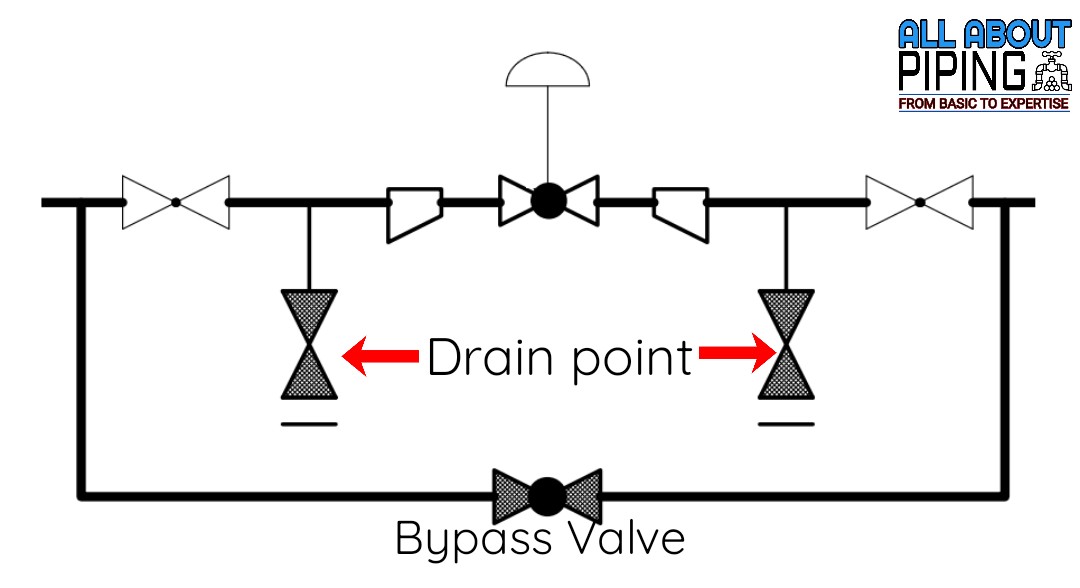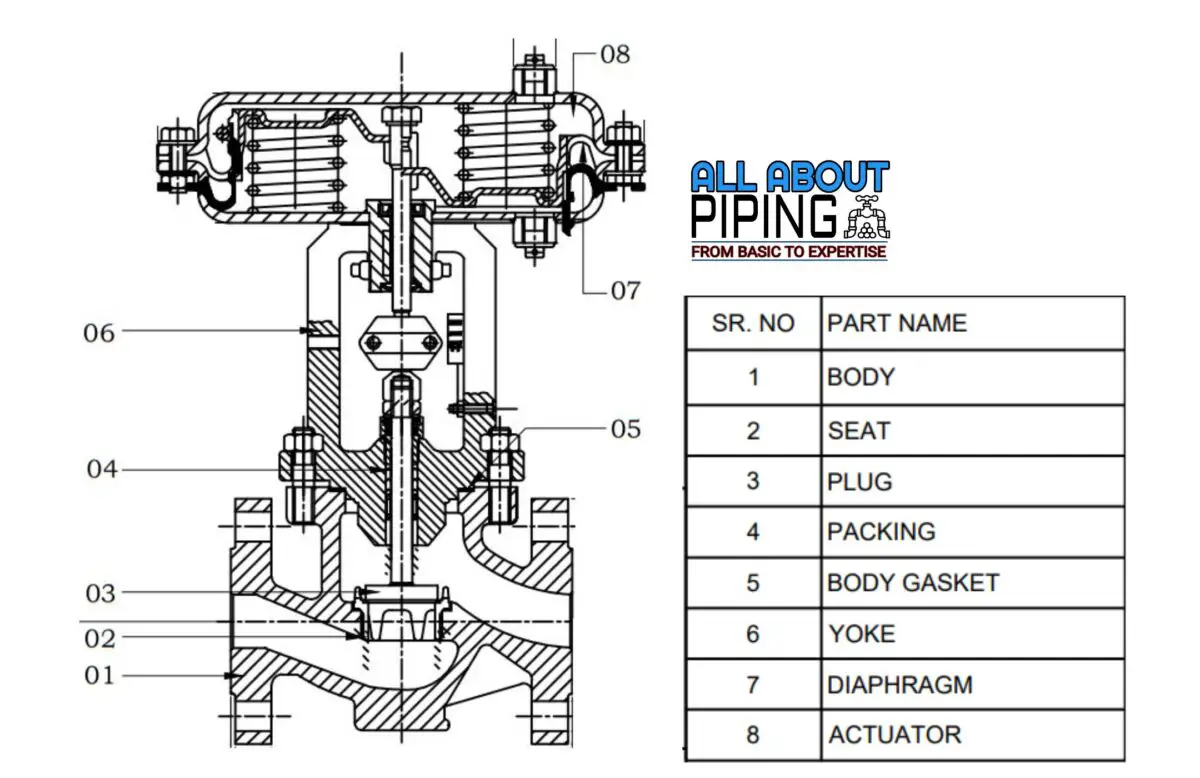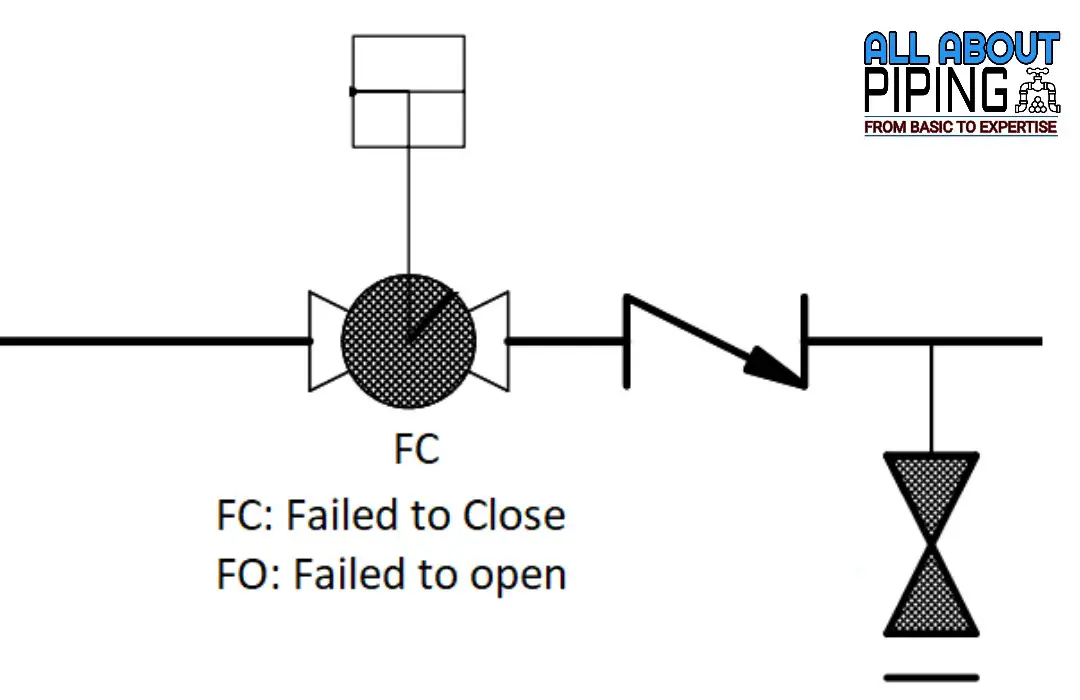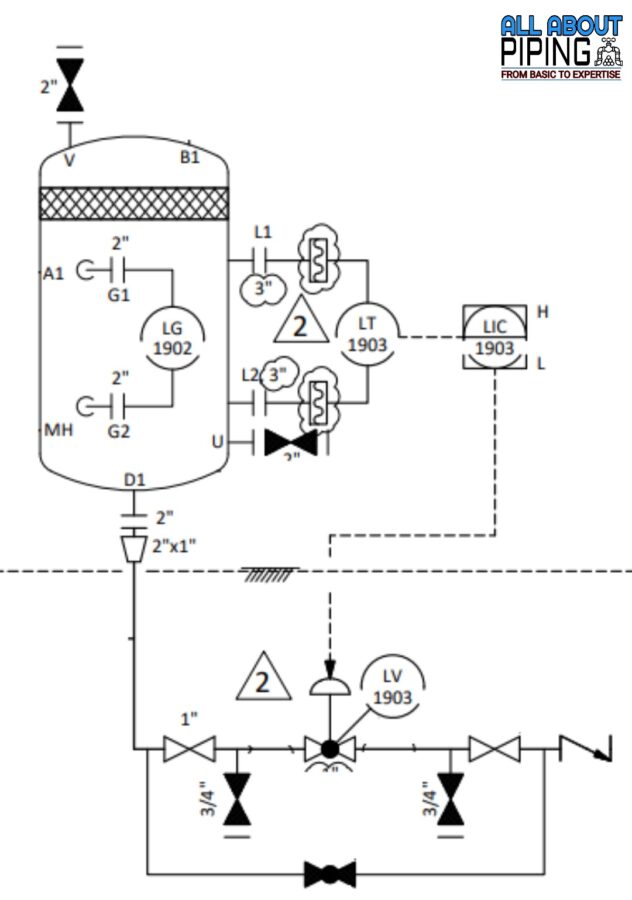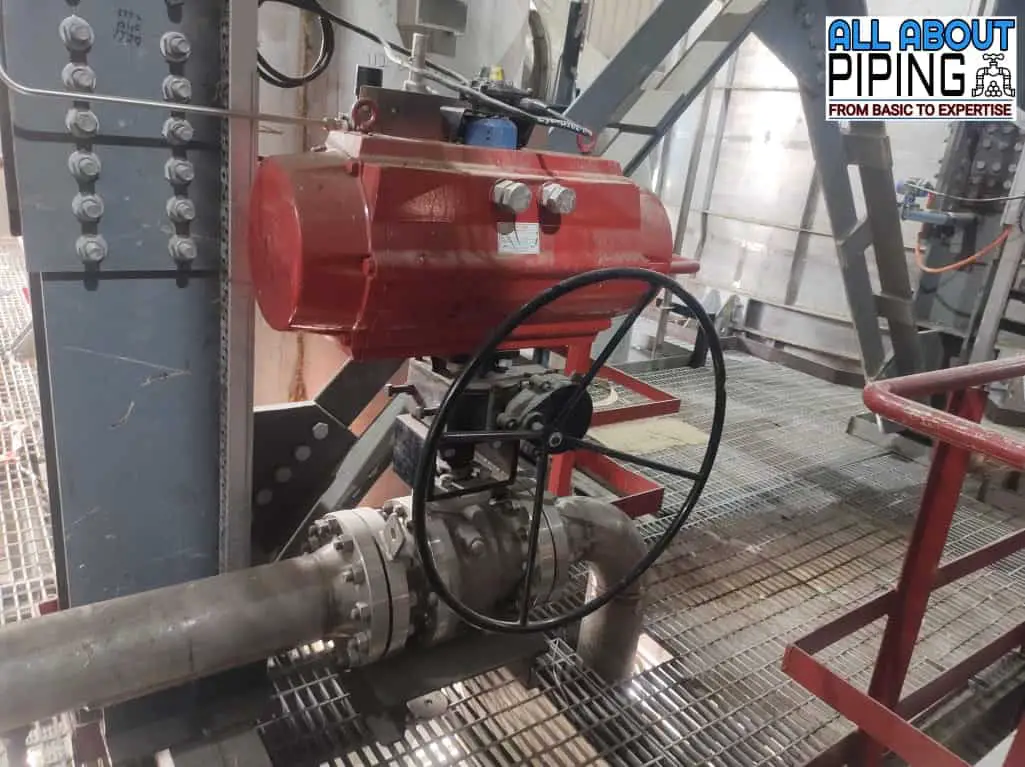In general, we are using different types of valves and control valves are one of the interesting parts of the piping network. Because of this, a piping circuit can be automated for flow control to maintain the desired level of fluid or flow rate according to temperature, pressure, and flow types.
We have used many valves with the nomenclature of FV, PV, HV, XV, etc without knowing the actual function and description of their abbreviated names. In this article we will learn about:
- Different control valve abbreviations
- How the control valve works
- The general design aspect of the control valve and many more.
More to Read: What is Disc Valve Diffuser? Purpose of Valve Diffuser in Piping
Table of Contents
General arrangement of control valve Installation
As depicted above, Control valve installation arrangement always consists of the following:
- 02 nos. of Isolation valves (Normally Gate valves) on either side are used to Isolate the flow through the line during any maintenance or repair of the control valve.
- 02 nos. of Drain points with end blind, which is used to drain out the fluid in the system before dismantling the control valve.
- 01 No. of globe valve which acts as a bypass valve when the control valve is not in line with the system and is dismantled for any repair or maintenance work.
More Resources: Falling film evaporator: Design, Working, Features and Application
General arrangement of Control valve
A control valve is a critical component in many industrial processes requiring precise fluid flow rate control. It regulates the flow of fluids, such as gases, liquids, or slurries, through a pipeline or channel by adjusting the size of the flow passage.
The control valve typically consists of several key components that work together to regulate the flow rate, direction, and pressure of the fluid:
- Valve body: This is the primary component of the control valve that provides a path for fluid flow.
- Valve trim: This component interacts with the fluid flow to regulate the rate and direction of flow. Valve trim includes parts such as a plug, seat, stem, and other internal components.
- Actuator: An actuator generates the force required to move the valve stem and control the flow of fluid. The actuator can be pneumatic, electric, or hydraulic.
- Positioner: This component receives a control signal from a controller and adjusts the valve’s position to maintain the desired flow rate. A positioner can be either pneumatic or electronic.
- Instrumentation: The instrumentation includes sensors and other devices that measure process parameters like pressure, temperature, and flow rate. The information is used to provide feedback to the controller and ensure the desired flow rate is maintained.
- Accessories: Additional components may be added to the valve, such as a handwheel for manual operation, limit switches to indicate valve position, or solenoid valves to control air or electrical signals.
The arrangement of these components may vary depending on the type of control valve and its application. For example, globe valves, ball valves, and gate valves have different arrangements. However, the underlying principles remain the same, with the valve body, trim, actuator, and instrumentation working together to regulate fluid flow through the system.
The proper selection and use of control valves are essential for efficient industrial processes. Control valves help maintain precise and stable flow rates, reduce energy consumption, and optimize process performance.
Overall, a control valve is a complex system with multiple components that work in concert to regulate the flow of fluids in industrial processes. It is critical to select and operate the right control valve for the application to achieve optimal process performance.
More Resources: 1G, 2G, 3G Bioethanol: What are different Bioethanol generation technologies?
Working principle of control valve
A control valve works on the principle of controlling the flow of fluid by adjusting the size of the flow passage. The valve body provides a path for the fluid flow, while the valve trim regulates the rate and direction of flow. The valve trim consists of components like a plug, seat, stem, and other internal parts that interact with the fluid flow to regulate the flow rate.
The valve’s actuator generates the force required to move the valve stem and control the flow of fluid. Depending on the application’s requirements, the actuator can be pneumatic, electric, or hydraulic. When the control signal is received, the actuator moves the valve stem, which changes the position of the valve trim, thus regulating the flow of fluid.
The valve’s positioner receives a control signal from a controller, determining the desired flow rate. The positioner then adjusts the valve’s position to maintain the desired flow rate. Depending on the application’s requirements, the positioner can be either pneumatic or electronic.
The control valve’s instrumentation includes sensors and other devices that measure process parameters like pressure, temperature, and flow rate. The information is used to provide feedback to the controller and ensure the desired flow rate is maintained.
Actuator types of control valves
Control valves use various types of actuators to control the flow of fluids. These actuators generate the force required to move the valve stem and adjust the flow passage’s size. The most commonly used types of actuators in control valves are pneumatic, electric, hydraulic, and electro-hydraulic.
- Pneumatic actuators: use compressed air as a power source to move the valve stem and adjust the flow of fluid. They are usually used in small to medium-sized valves and are cost-effective and straightforward. Electric actuators, on the other hand, use electric power to move the valve stem and control fluid flow. They are more precise than pneumatic actuators and are commonly used for large valves that require accurate control.
- Hydraulic actuators: use hydraulic fluid as a power source to move the valve stem and control fluid flow. They are commonly used for high-pressure applications or where precise control is required. Electro-hydraulic actuators combine the precision of electric actuators with the power of hydraulic actuators. They use an electric motor to drive a hydraulic pump that powers the actuator.
- Electric Actuators: These actuators use electric power to move the valve stem and control fluid flow. Electric actuators are more precise than pneumatic actuators and are commonly used for large valves that require precise control.
- Electro-Hydraulic Actuators: These actuators combine the precision of electric actuators with the power of hydraulic actuators. They use an electric motor to drive a hydraulic pump that powers the actuator.
The selection of the appropriate actuator for a control valve depends on several factors, such as the valve’s size, required flow rate and pressure, and the level of precision needed. Each type of actuator has its advantages and disadvantages, and the selection of the correct actuator is essential to achieve optimal process performance.
Control valve body types
Control valves come in different body types, each with unique features that make them suitable for specific applications. Some of the common body types of control valves include:
- Globe Valves: These valves have a spherical body shape and an internal baffle that directs the fluid flow through the valve. They are commonly used to control flow in pipelines.
- Ball Valves: These valves have a ball-shaped body with a hole through the center. The ball rotates to control the flow of fluid. Ball valves are ideal for on/off applications.
- Butterfly Valves: These valves have a disc-shaped body with a rotatable disc inside that controls fluid flow. They are ideal for applications that require a quick shut-off.
- Diaphragm Valves: These valves have a flexible diaphragm that moves up and down to control fluid flow. They are ideal for applications where fluid contamination is a concern.
- Pinch Valves: These valves have a flexible sleeve that is pinched to control fluid flow. They are ideal for applications where the fluid contains solids or other debris.
- Needle Valves: These valves have a slender, tapered body with a needle-shaped plunger that controls fluid flow. They are ideal for applications that require precise control of fluid flow.
More resources: Type and Selection of Hydraulic Oil
General Feature of different control valves
According to the selection of valve type used to manufacture the control valve its features and characteristics are different and according to design requirements. Some of the general characteristics of different types of control valves are as follows:
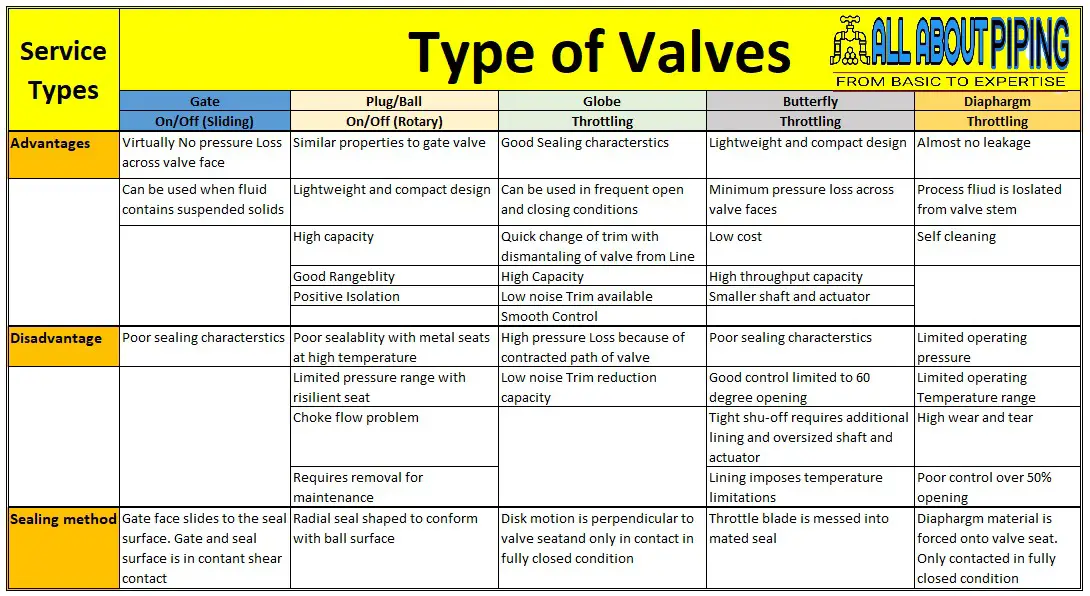
Abbreviation used for different types of control valves
Normally we come across various abbreviations of control valves viz. XV, PV, TV, LV, etc. Each of these control valves has different functionality and is used to control other parameters of processing systems.
Here we will know about each of these tags and its description in Detail:
On-off Control valve (XV)
XV is the type of control valve that controls the flow of fluid. Generally, XV indicates on-off type control valve. this means it either allows fluid to flow through it or stops it completely.
In general, this type of control valve doesn’t possess any bypass valve as a secondary arrangement. XV type valve is always chosen either from these 02 operational methods as follows:
- Failed to Close (FC): This is generally indicated just below the valve symbol in P&ID. Failed to close suggests the valve’s functionality which informs that, this valve will stop the flow of process fluid if anything goes wrong with this valve.
- Failed to open (FO): Just opposite the above type, FO written below the control valve symbol indicates it will remain open if anything goes wrong.
FC or FO can be chosen according to the requirement of processing fluid.
Pressure control valve (PV)
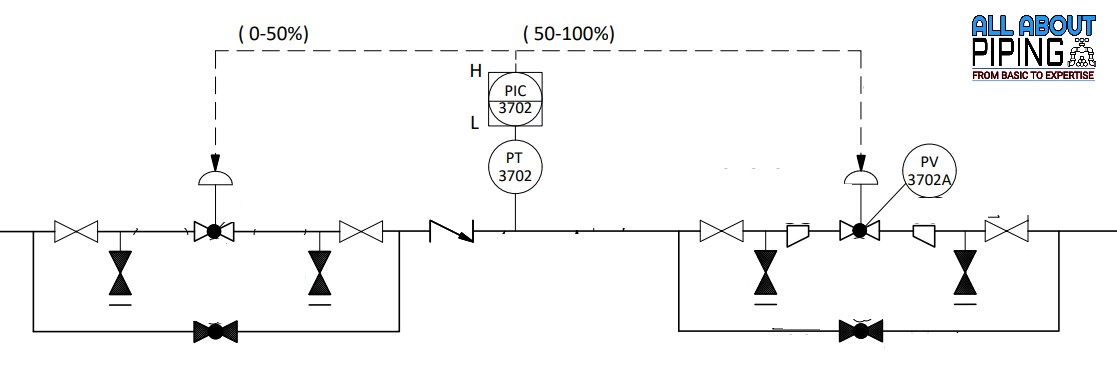
As the name suggests, A pressure control valve or PV is a type of valve commonly used to regulate and control fluid pressure in a system. The main function of the valve is to maintain a consistent pressure level within a specific range, regardless of any changes in the upstream or downstream pressure.
The operation of a pressure control valve involves opening and closing in response to changes in pressure, which helps to regulate the flow of fluid through the system. If the pressure exceeds the set point, the valve opens to allow fluid to escape and reduce the pressure. Conversely, if the pressure drops below the set point, the valve closes to prevent fluid from escaping and increasing pressure.
As shown in the above image, the Pressure control valve is indicated to connect with the pressure transmitter of the line which sends the indication to the controller to operate the valves in the required percentage of opening to maintain the pressure of the process.
Note: In general, the Tag no. of the pressure transmitter and pressure control valve or PV is always the same for easy identification and regulation of the system.
Flow control valve (FV)
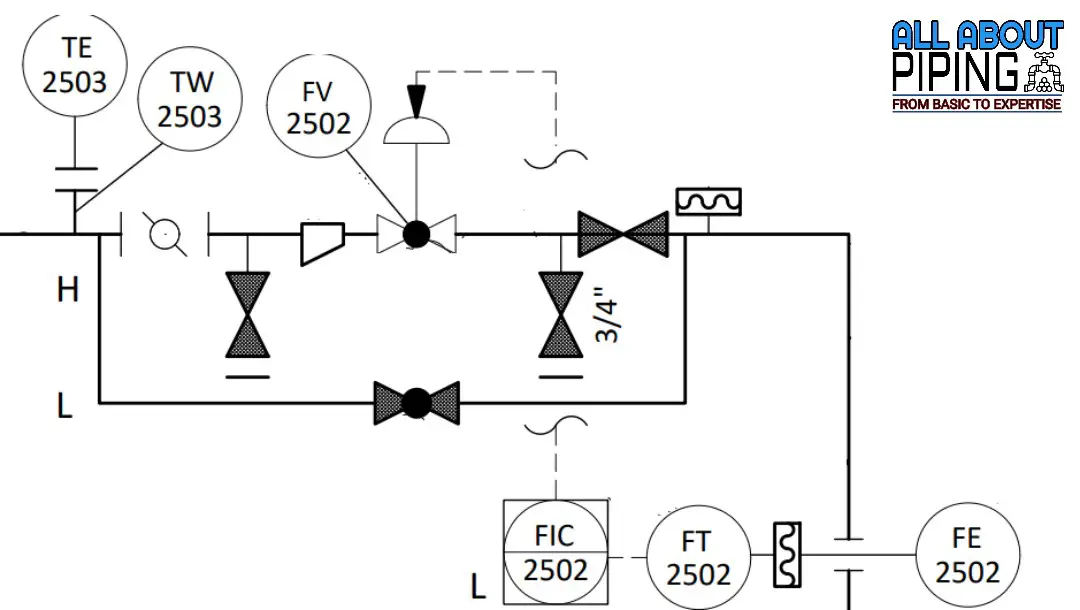
A flow control valve or FV is a type of valve that helps regulate and control the flow rate of a fluid in a system. It works by changing the size of the valve opening to maintain a consistent flow rate within a specific range, no matter what’s happening upstream or downstream.
If the flow rate goes too high, the valve reduces the size of the opening to limit the flow. If the flow rate goes too low, the valve increases the size of the opening to allow more fluid to flow.
Flow control valves are used in many industries, like water treatment, chemical processing, and oil and gas. They help control the flow of liquids and gases in pipelines and tanks. Flow control valves come in different types, including globe valves, needle valves, and ball valves, and can be controlled manually or automatically.
A flow control valve gets a control signal from a flow meter (as in the image above) to adjust the valve element position, maintaining the desired flow rate. In manual flow control valves, the operator adjusts the valve element position to control the flow rate.
If the fluid flow rate surpasses the predetermined level, the valve element is lowered by the stem to reduce the size of the opening and decrease the flow rate. Conversely, if the flow rate falls below the set point, the valve element is raised by the stem to increase the size of the opening, enabling more fluid to pass through.
Temprature control valve (TV)
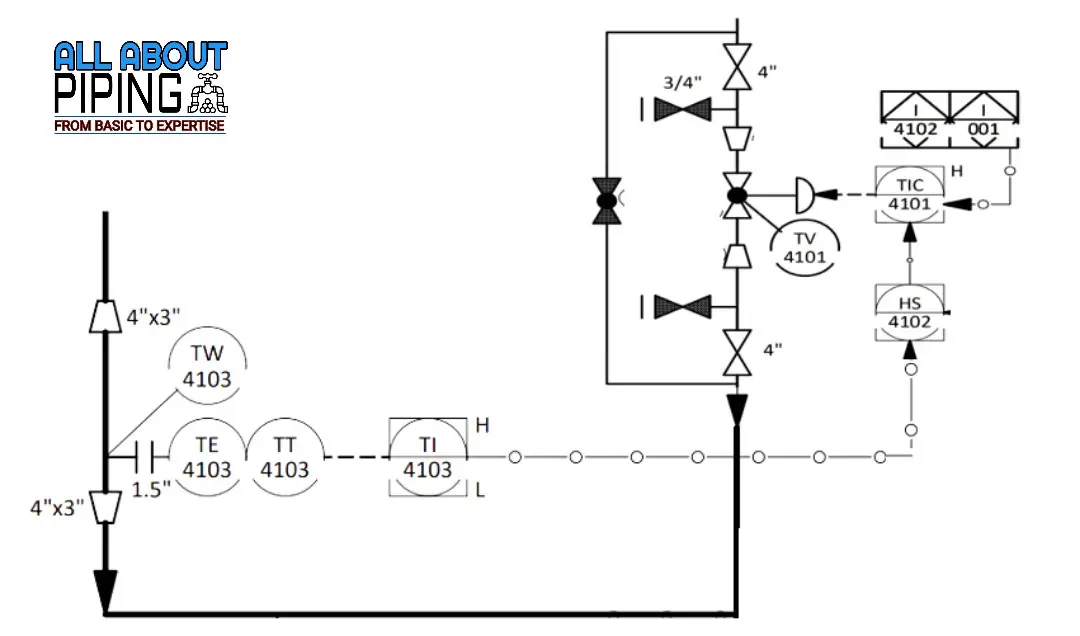
A temperature control valve or TV is a type of valve that is used to regulate and control the temperature of the fluid in a system. Its primary function is to maintain a consistent temperature within a specified range, despite changes in upstream or downstream conditions.
The temperature control valve is typically installed in a pipeline or vessel within the processing system, and it is connected to a temperature sensor that monitors the temperature of the fluid or the processing system. If the temperature rises above or falls below the desired set point, the valve will adjust the flow of hot or cold fluid to maintain the desired temperature range.
In an automatic temperature control system, the valve is controlled by a temperature controller that receives input from the temperature sensor and adjusts the valve accordingly. The controller can be programmed to maintain a specific temperature range, and it can also be configured to provide alarms or shut off the process if the temperature deviates too far from the desired set point.
The temperature control valve is connected to a temperature element or thermowell to detect temperature and send the signal to operate the control valve accordingly
Level Control Valve (LV)
Level control valve or LV is a device used to maintain a consistent fluid level within a tank or vessel. It works by regulating the flow of liquid into or out of the tank, in response to changes in the fluid level. The valve ensures that the fluid level remains within a specific range, which can help prevent overflows, underflows, or other issues.
The level control valve is typically installed in a pipeline or vessel that is connected to the tank or vessel. It is connected to a level sensor that monitors the fluid level within the tank. When the fluid level rises above or falls below the desired set point, the level control valve adjusts the flow of liquid accordingly.
For example, if the fluid level rises above the desired set point, the valve will reduce the liquid flow into the tank, which will lower the level. Conversely, if the fluid level falls below the desired set point, the valve will increase the flow of liquid into the tank, which will raise the level.
As depicted in the image, the Level control valve or LV is connected to a level transmitter that communicates with the valve to operate and control flow accordingly.
Handle-operated control valve (HV)
Handle-operated control valves or HV are a type of valve that is manually controlled through the use of a handle or lever. They are commonly used in applications where manual control is necessary or preferred, particularly in low-pressure or small-scale systems.
The handle or lever on a handle-operated control valve is directly connected to the valve stem, which moves the valve element to regulate the flow of fluid or gas through the valve. Rotating the handle clockwise or counterclockwise adjusts the position of the valve element, which in turn regulates the flow of fluid or gas.
These valves can be used to control the flow, pressure, or temperature of fluids or gases in various industrial processes, such as in heating and cooling systems, chemical processing facilities, and water treatment plants.
One advantage of handle-operated control valves is their simplicity and ease of use. They do not require any external power source or complex control system, which makes them a cost-effective option for many applications. Furthermore, manual control allows for quick adjustments and immediate response to changes in process conditions.
However, handle-operated control valves have some limitations. They require human intervention to operate, which can be time-consuming and labor-intensive in large-scale systems. Additionally, they may not be as precise or accurate as automated control valves, which can result in fluctuations or inconsistencies in the process.
Remote-operated shutoff valve (ROSOV)
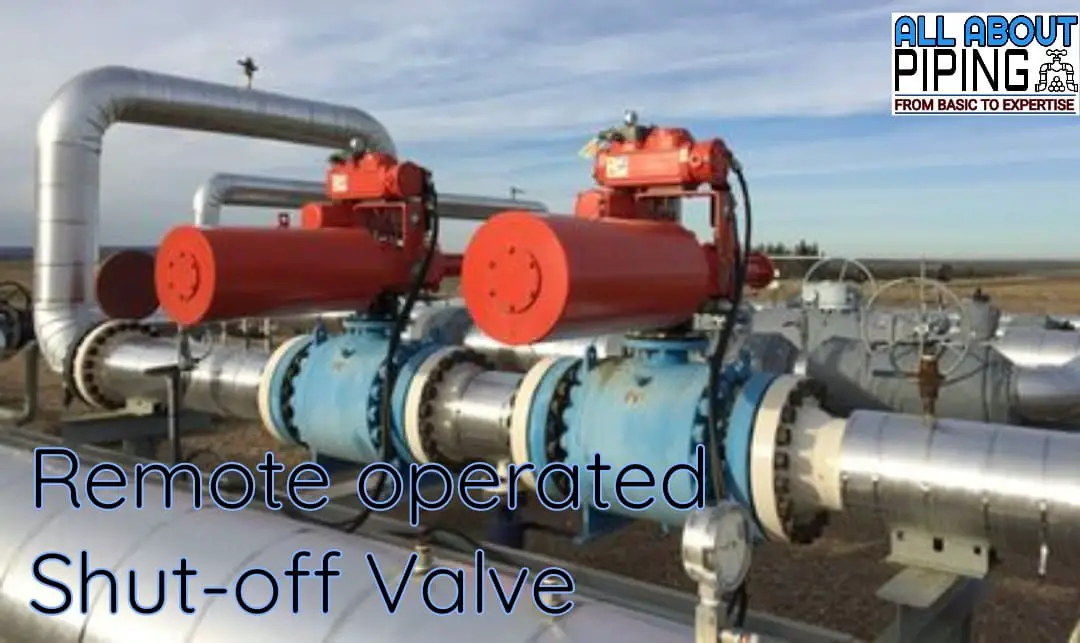
A remote-operated shutoff valve or ROSOV is a type of control valve that can be controlled remotely through an electronic device or computer. These valves are used in various industrial settings, including oil and gas pipelines, water treatment facilities, and chemical plants. They are typically installed in hard-to-reach or hazardous locations, such as deep underground or offshore.
In emergency situations or as part of routine maintenance, the valve can be remotely shut off to prevent further damage or dangerous situations. This feature reduces the need for workers to physically access the valve, decreasing the likelihood of accidents or injuries. Therefore, remote-operated shutoff valves are crucial for safety in industrial settings.
In short, remote-operated shutoff valves are a vital safety measure in many industries, safeguarding workers, and the environment, and preventing accidents.
Selection of control valve
When selecting a control valve, there are several criteria to consider, including:
- Valve type: The type of valve chosen should be based on the application requirements, such as flow rate, pressure drop, and fluid characteristics.
- Valve size: The valve size should match the process flow rate and pipe size to avoid issues like high-pressure drop or inefficiency.
- Valve material: The material used for the valve should be compatible with the process fluid and operating conditions, such as temperature, pressure, and corrosion resistance.
- Flow characteristic: Control valves have different flow characteristics, such as linear, equal percentage, and quick opening. The flow characteristic selected should meet the desired control response and process requirements.
- Actuator type: Depending on the process requirements and available power sources, the actuator can be pneumatic, electric, or hydraulic.
- Maintenance requirements: Valve maintenance requirements, such as ease of access, repair, and parts replacement, should be considered.
- Cost: The cost of the valve and associated equipment, such as actuators and positioners, should be considered. The total cost of ownership over the valve’s life cycle should also be factored in.
By considering these criteria carefully, you can choose the right control valve for your process control system and ensure optimal performance and efficiency.
Conclusion
Control valves are an essential component in regulating the flow, pressure, and temperature of fluids in various industrial processes. They are crucial in systems such as oil and gas production, chemical processing, and water treatment, among others.
The appropriate type of control valve is selected based on the application and specific control requirements. Proper selection, installation, and maintenance of control valves are essential for their optimal performance and longevity.
Technological advancements have resulted in the development of more sophisticated control valves that offer higher accuracy, reliability, and efficiency. Given their crucial role in process control, control valves will continue to play a vital role in numerous industries.
